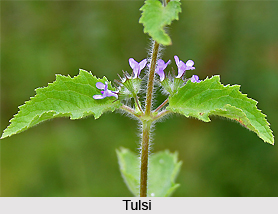 Tulsi is a native plant of India and is religiously significant. Planting tulsi inside the house is a common phenomenon. Tulsi is a Sanskrit name. The name Tulsi refers to one who does not tolerate. Tulsi, in fact, is a symbol of culture and religious inclinations of the family. The scientific name for tulsi is Ocimum tenuiflorum. It is also known as Holy Basil in English. However there are other species of Tulsi as well. For instance, Hyptis suaveolens, Ocimum americanum, Ocimum gratissimum, Ocimum sanctum and others are also found in India. Abundantly found in rural areas, it is called `Gramya`, the village maiden. It has also earned the name Shoolaghni, because of its ability to alleviate pain. One of the English names for Tulsi is `the Mosquito Plant`. Sir George Birdward wrote that the Victoria Gardens and the Prince Albert Museum were `malarial`. The cultivation of the Tulsi plants freed it from mosquitoes. Besides these, tulsi is also known as Surasa and Sulabha.
Tulsi is a native plant of India and is religiously significant. Planting tulsi inside the house is a common phenomenon. Tulsi is a Sanskrit name. The name Tulsi refers to one who does not tolerate. Tulsi, in fact, is a symbol of culture and religious inclinations of the family. The scientific name for tulsi is Ocimum tenuiflorum. It is also known as Holy Basil in English. However there are other species of Tulsi as well. For instance, Hyptis suaveolens, Ocimum americanum, Ocimum gratissimum, Ocimum sanctum and others are also found in India. Abundantly found in rural areas, it is called `Gramya`, the village maiden. It has also earned the name Shoolaghni, because of its ability to alleviate pain. One of the English names for Tulsi is `the Mosquito Plant`. Sir George Birdward wrote that the Victoria Gardens and the Prince Albert Museum were `malarial`. The cultivation of the Tulsi plants freed it from mosquitoes. Besides these, tulsi is also known as Surasa and Sulabha.
Types of Tulsi
Three types of Tulsi are generally found in the Indian subcontinent: Rama Tulsi has green leaves, the Krishna Tulsi generally has purple leaves and the Vana Tulsi. The medicinal value as well as the size of Tulsi varies to a large extent with the changes in rainfall and the type of soil in which they are grown.
The Tulsi plant or the holy basil is three to four feet tall. Though black sticky and moist soils are most suitable for its growth but it can be cultivated on other soils as well. The plant bears inflorescences about two inches long. The maximum diameter of the trunk may be about the size of a wrist, and the branches may grow to a thickness of half an inch. The leaves are of an elongated oval shape.
Tulsi has a sharp taste and an odour which kills germs. It is always used when fresh. A number of household remedies are prepared by mixing Tulsi with dry ginger, pepper, billa fruit pulp, the tender shoots of the neem tree, cardamom, and such other ingredients.
 Uses of Tulsi
Uses of Tulsi
The uses of tulsi are manifold. In India these are primarily known for their medicinal values. The leaves of tulsi are used to treat a number of diseases like coughs, bronchitis, skin diseases, diarrhoea, cholera, influenza and malaria. Tulsi seeds are used to treat ulcers, vomiting, low energy levels and it acts as an over all tonic.
Recent research has shown that small doses of Tulsi are able to protect a person against high blood pressure. It also helps to control high blood sugar levels. Tulsi is also believed to cancer at bay. Tulsi plant is rich in bio available antioxidants, Vitamins A and C.
The prac
titioners of the Unani system regard that Tulsi stimulates the activity of the brain, reduces swellings, destroys gas, relieves congestion in the heart, stimulates the appetite, and counters dilapidation of the skin and vitiation of the blood.
A decoction of the plant is taken internally to relieve coughs and fever. The leaves for used for treating dysentery and as a mouthwash for relieving toothache. The leaves, widely used for flavouring sauces, soups and salads, are considered diuretic and tonic. The leaf paste is used externally for treating parasitic skin diseases.
Besides the medicinal uses, tulsi is also used in several Hindu rituals. Its leaves are offered to gods while worshipping. The leaves are given prime position in religious rituals, as prasad or offerings to Gods, in devotion, in preparing `Panchamrit` and in alms to the poor. It is even believed that the messengers of death (diseases) cannot approach a home where Tulsi is planted. Vedas mention that God does not accept any offering if it does not include Tulsi leaves. Indian Puranas describes Tulsi as the consort of Lord Krishna.











